Financial Reporting: Cash Flow Statement and Stakeholder Information
VerifiedAdded on 2020/07/22
|7
|1338
|40
Report
AI Summary
This report analyzes the importance of cash flow statements in financial reporting, emphasizing their significance in providing stakeholders with useful information. It explores how cash flow statements help in monitoring business debt, preventing unnecessary expenses, ensuring timely investments, and identifying investment opportunities. The report also discusses the benefits of integrated reporting in improving data quality and providing a comprehensive overview of financial performance, including qualitative and quantitative data. Furthermore, it critically analyzes the philosophies behind rule-based and principle-based accounting standards, highlighting the advantages of a principle-based system for adapting to the nature of transactions. The conclusion summarizes the key findings, reinforcing the importance of cash flow statements and integrated reporting in maintaining financial balance and providing stakeholders with relevant data for decision-making. The report references several books and journals to support its analysis.

Financial Reporting
Paraphrase This Document
Need a fresh take? Get an instant paraphrase of this document with our AI Paraphraser
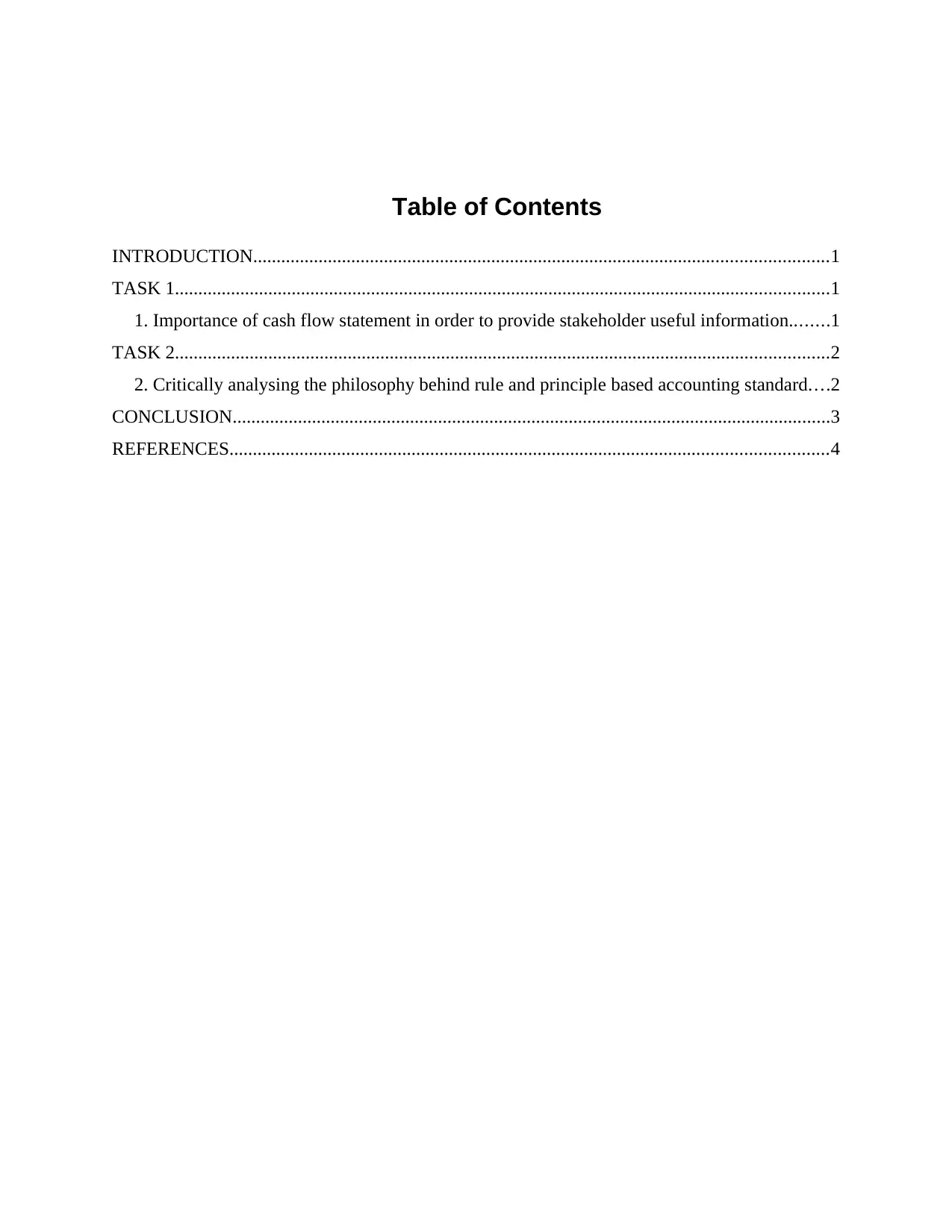
Table of Contents
INTRODUCTION...........................................................................................................................1
TASK 1............................................................................................................................................1
1. Importance of cash flow statement in order to provide stakeholder useful information........1
TASK 2............................................................................................................................................2
2. Critically analysing the philosophy behind rule and principle based accounting standard....2
CONCLUSION................................................................................................................................3
REFERENCES................................................................................................................................4
INTRODUCTION...........................................................................................................................1
TASK 1............................................................................................................................................1
1. Importance of cash flow statement in order to provide stakeholder useful information........1
TASK 2............................................................................................................................................2
2. Critically analysing the philosophy behind rule and principle based accounting standard....2
CONCLUSION................................................................................................................................3
REFERENCES................................................................................................................................4
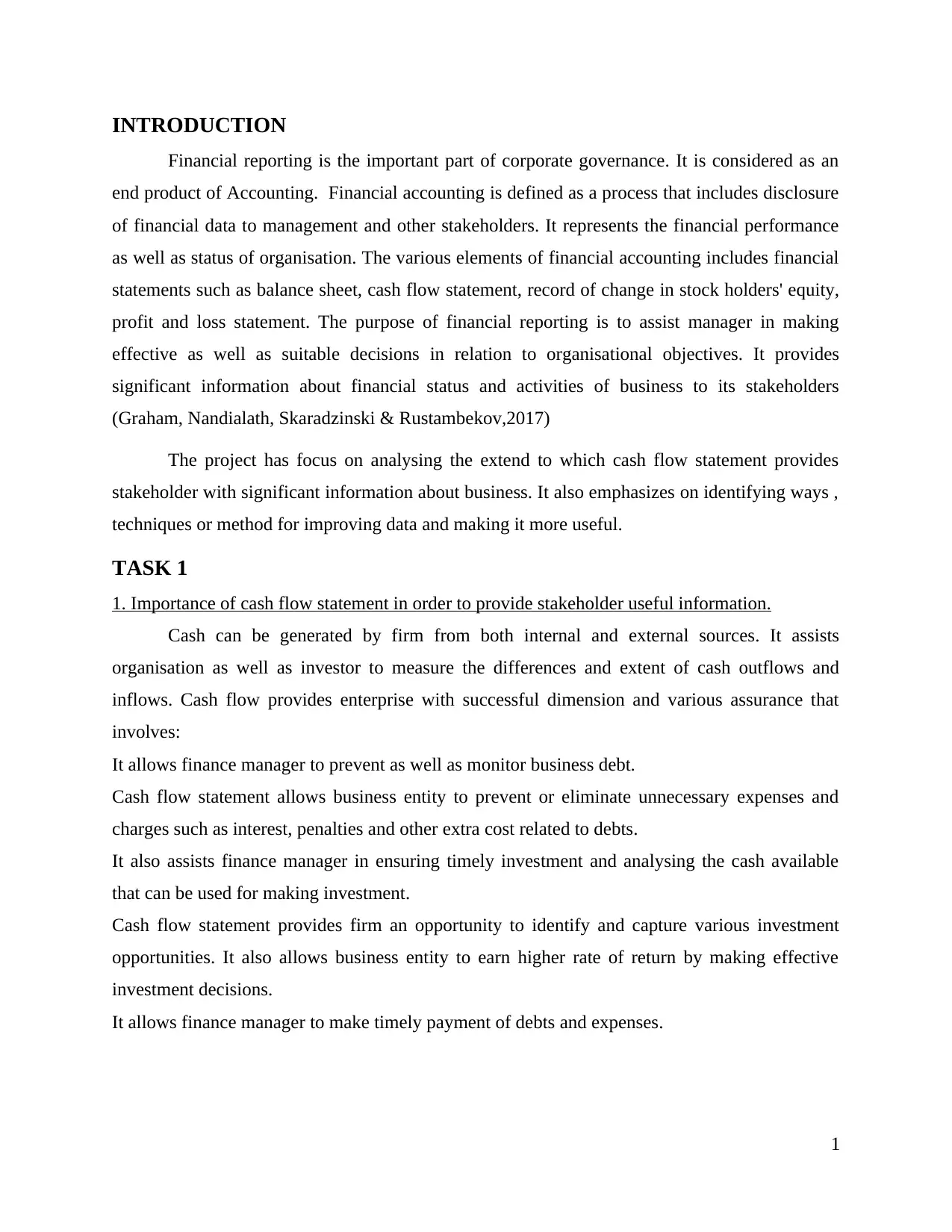
INTRODUCTION
Financial reporting is the important part of corporate governance. It is considered as an
end product of Accounting. Financial accounting is defined as a process that includes disclosure
of financial data to management and other stakeholders. It represents the financial performance
as well as status of organisation. The various elements of financial accounting includes financial
statements such as balance sheet, cash flow statement, record of change in stock holders' equity,
profit and loss statement. The purpose of financial reporting is to assist manager in making
effective as well as suitable decisions in relation to organisational objectives. It provides
significant information about financial status and activities of business to its stakeholders
(Graham, Nandialath, Skaradzinski & Rustambekov,2017)
The project has focus on analysing the extend to which cash flow statement provides
stakeholder with significant information about business. It also emphasizes on identifying ways ,
techniques or method for improving data and making it more useful.
TASK 1
1. Importance of cash flow statement in order to provide stakeholder useful information.
Cash can be generated by firm from both internal and external sources. It assists
organisation as well as investor to measure the differences and extent of cash outflows and
inflows. Cash flow provides enterprise with successful dimension and various assurance that
involves:
It allows finance manager to prevent as well as monitor business debt.
Cash flow statement allows business entity to prevent or eliminate unnecessary expenses and
charges such as interest, penalties and other extra cost related to debts.
It also assists finance manager in ensuring timely investment and analysing the cash available
that can be used for making investment.
Cash flow statement provides firm an opportunity to identify and capture various investment
opportunities. It also allows business entity to earn higher rate of return by making effective
investment decisions.
It allows finance manager to make timely payment of debts and expenses.
1
Financial reporting is the important part of corporate governance. It is considered as an
end product of Accounting. Financial accounting is defined as a process that includes disclosure
of financial data to management and other stakeholders. It represents the financial performance
as well as status of organisation. The various elements of financial accounting includes financial
statements such as balance sheet, cash flow statement, record of change in stock holders' equity,
profit and loss statement. The purpose of financial reporting is to assist manager in making
effective as well as suitable decisions in relation to organisational objectives. It provides
significant information about financial status and activities of business to its stakeholders
(Graham, Nandialath, Skaradzinski & Rustambekov,2017)
The project has focus on analysing the extend to which cash flow statement provides
stakeholder with significant information about business. It also emphasizes on identifying ways ,
techniques or method for improving data and making it more useful.
TASK 1
1. Importance of cash flow statement in order to provide stakeholder useful information.
Cash can be generated by firm from both internal and external sources. It assists
organisation as well as investor to measure the differences and extent of cash outflows and
inflows. Cash flow provides enterprise with successful dimension and various assurance that
involves:
It allows finance manager to prevent as well as monitor business debt.
Cash flow statement allows business entity to prevent or eliminate unnecessary expenses and
charges such as interest, penalties and other extra cost related to debts.
It also assists finance manager in ensuring timely investment and analysing the cash available
that can be used for making investment.
Cash flow statement provides firm an opportunity to identify and capture various investment
opportunities. It also allows business entity to earn higher rate of return by making effective
investment decisions.
It allows finance manager to make timely payment of debts and expenses.
1
⊘ This is a preview!⊘
Do you want full access?
Subscribe today to unlock all pages.

Trusted by 1+ million students worldwide
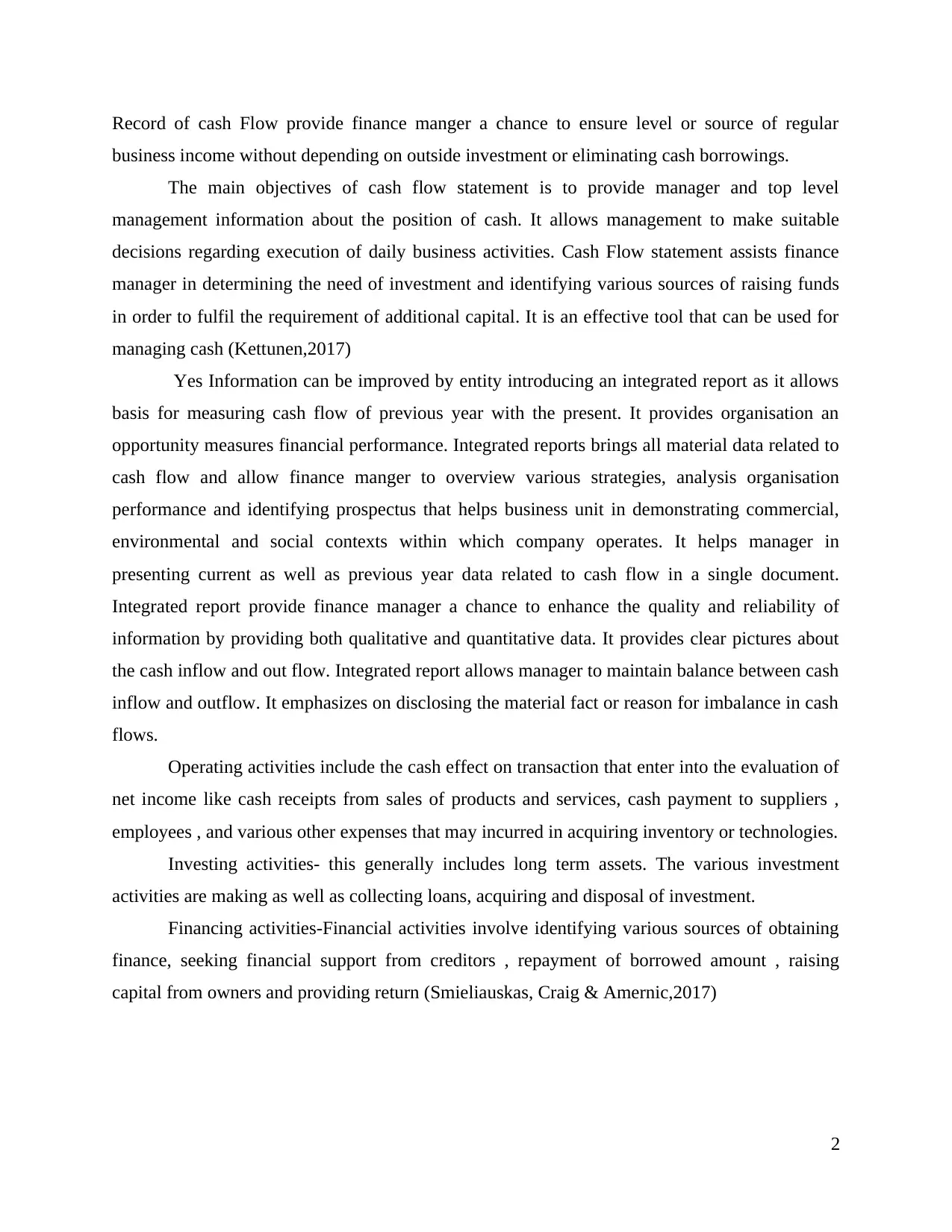
Record of cash Flow provide finance manger a chance to ensure level or source of regular
business income without depending on outside investment or eliminating cash borrowings.
The main objectives of cash flow statement is to provide manager and top level
management information about the position of cash. It allows management to make suitable
decisions regarding execution of daily business activities. Cash Flow statement assists finance
manager in determining the need of investment and identifying various sources of raising funds
in order to fulfil the requirement of additional capital. It is an effective tool that can be used for
managing cash (Kettunen,2017)
Yes Information can be improved by entity introducing an integrated report as it allows
basis for measuring cash flow of previous year with the present. It provides organisation an
opportunity measures financial performance. Integrated reports brings all material data related to
cash flow and allow finance manger to overview various strategies, analysis organisation
performance and identifying prospectus that helps business unit in demonstrating commercial,
environmental and social contexts within which company operates. It helps manager in
presenting current as well as previous year data related to cash flow in a single document.
Integrated report provide finance manager a chance to enhance the quality and reliability of
information by providing both qualitative and quantitative data. It provides clear pictures about
the cash inflow and out flow. Integrated report allows manager to maintain balance between cash
inflow and outflow. It emphasizes on disclosing the material fact or reason for imbalance in cash
flows.
Operating activities include the cash effect on transaction that enter into the evaluation of
net income like cash receipts from sales of products and services, cash payment to suppliers ,
employees , and various other expenses that may incurred in acquiring inventory or technologies.
Investing activities- this generally includes long term assets. The various investment
activities are making as well as collecting loans, acquiring and disposal of investment.
Financing activities-Financial activities involve identifying various sources of obtaining
finance, seeking financial support from creditors , repayment of borrowed amount , raising
capital from owners and providing return (Smieliauskas, Craig & Amernic,2017)
2
business income without depending on outside investment or eliminating cash borrowings.
The main objectives of cash flow statement is to provide manager and top level
management information about the position of cash. It allows management to make suitable
decisions regarding execution of daily business activities. Cash Flow statement assists finance
manager in determining the need of investment and identifying various sources of raising funds
in order to fulfil the requirement of additional capital. It is an effective tool that can be used for
managing cash (Kettunen,2017)
Yes Information can be improved by entity introducing an integrated report as it allows
basis for measuring cash flow of previous year with the present. It provides organisation an
opportunity measures financial performance. Integrated reports brings all material data related to
cash flow and allow finance manger to overview various strategies, analysis organisation
performance and identifying prospectus that helps business unit in demonstrating commercial,
environmental and social contexts within which company operates. It helps manager in
presenting current as well as previous year data related to cash flow in a single document.
Integrated report provide finance manager a chance to enhance the quality and reliability of
information by providing both qualitative and quantitative data. It provides clear pictures about
the cash inflow and out flow. Integrated report allows manager to maintain balance between cash
inflow and outflow. It emphasizes on disclosing the material fact or reason for imbalance in cash
flows.
Operating activities include the cash effect on transaction that enter into the evaluation of
net income like cash receipts from sales of products and services, cash payment to suppliers ,
employees , and various other expenses that may incurred in acquiring inventory or technologies.
Investing activities- this generally includes long term assets. The various investment
activities are making as well as collecting loans, acquiring and disposal of investment.
Financing activities-Financial activities involve identifying various sources of obtaining
finance, seeking financial support from creditors , repayment of borrowed amount , raising
capital from owners and providing return (Smieliauskas, Craig & Amernic,2017)
2
Paraphrase This Document
Need a fresh take? Get an instant paraphrase of this document with our AI Paraphraser
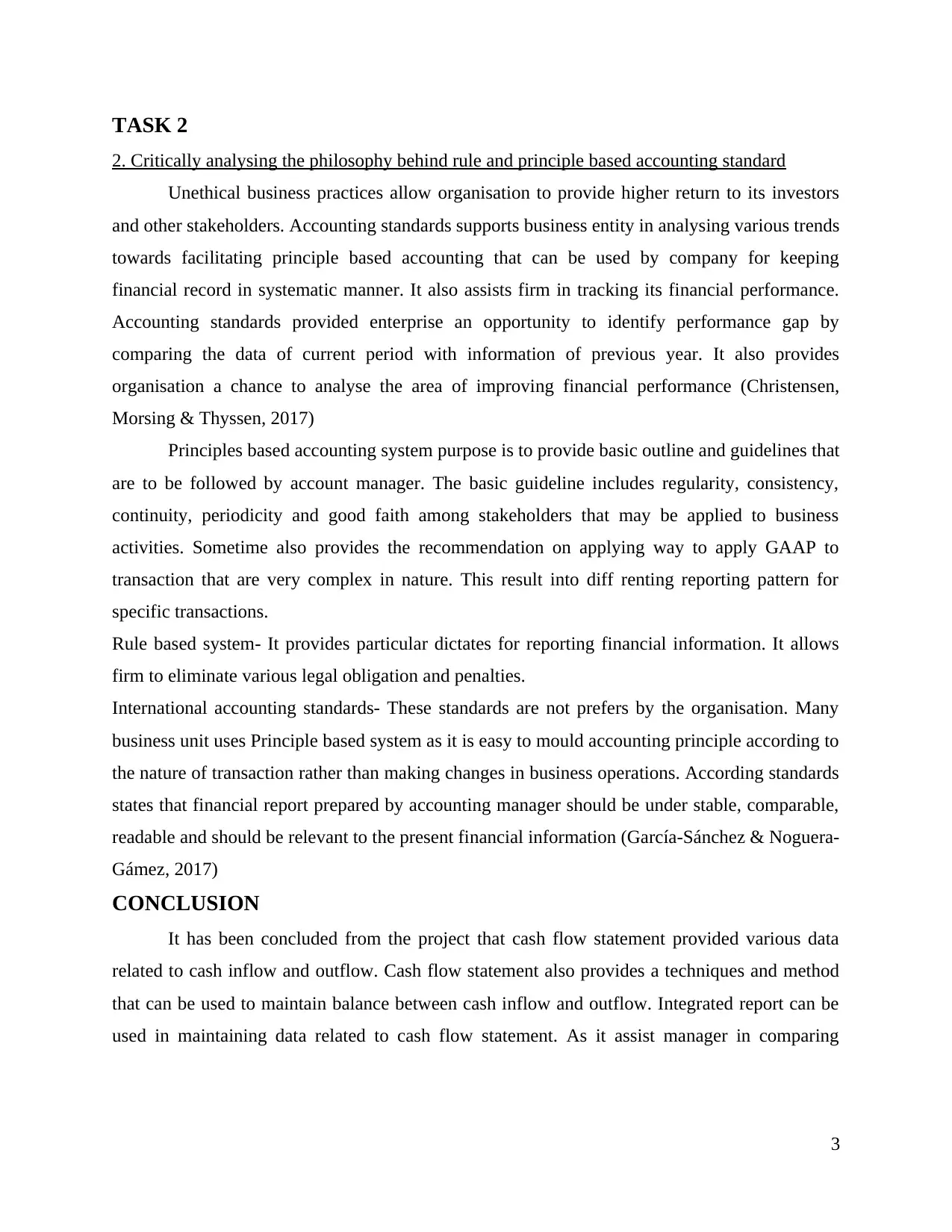
TASK 2
2. Critically analysing the philosophy behind rule and principle based accounting standard
Unethical business practices allow organisation to provide higher return to its investors
and other stakeholders. Accounting standards supports business entity in analysing various trends
towards facilitating principle based accounting that can be used by company for keeping
financial record in systematic manner. It also assists firm in tracking its financial performance.
Accounting standards provided enterprise an opportunity to identify performance gap by
comparing the data of current period with information of previous year. It also provides
organisation a chance to analyse the area of improving financial performance (Christensen,
Morsing & Thyssen, 2017)
Principles based accounting system purpose is to provide basic outline and guidelines that
are to be followed by account manager. The basic guideline includes regularity, consistency,
continuity, periodicity and good faith among stakeholders that may be applied to business
activities. Sometime also provides the recommendation on applying way to apply GAAP to
transaction that are very complex in nature. This result into diff renting reporting pattern for
specific transactions.
Rule based system- It provides particular dictates for reporting financial information. It allows
firm to eliminate various legal obligation and penalties.
International accounting standards- These standards are not prefers by the organisation. Many
business unit uses Principle based system as it is easy to mould accounting principle according to
the nature of transaction rather than making changes in business operations. According standards
states that financial report prepared by accounting manager should be under stable, comparable,
readable and should be relevant to the present financial information (García‐Sánchez & Noguera‐
Gámez, 2017)
CONCLUSION
It has been concluded from the project that cash flow statement provided various data
related to cash inflow and outflow. Cash flow statement also provides a techniques and method
that can be used to maintain balance between cash inflow and outflow. Integrated report can be
used in maintaining data related to cash flow statement. As it assist manager in comparing
3
2. Critically analysing the philosophy behind rule and principle based accounting standard
Unethical business practices allow organisation to provide higher return to its investors
and other stakeholders. Accounting standards supports business entity in analysing various trends
towards facilitating principle based accounting that can be used by company for keeping
financial record in systematic manner. It also assists firm in tracking its financial performance.
Accounting standards provided enterprise an opportunity to identify performance gap by
comparing the data of current period with information of previous year. It also provides
organisation a chance to analyse the area of improving financial performance (Christensen,
Morsing & Thyssen, 2017)
Principles based accounting system purpose is to provide basic outline and guidelines that
are to be followed by account manager. The basic guideline includes regularity, consistency,
continuity, periodicity and good faith among stakeholders that may be applied to business
activities. Sometime also provides the recommendation on applying way to apply GAAP to
transaction that are very complex in nature. This result into diff renting reporting pattern for
specific transactions.
Rule based system- It provides particular dictates for reporting financial information. It allows
firm to eliminate various legal obligation and penalties.
International accounting standards- These standards are not prefers by the organisation. Many
business unit uses Principle based system as it is easy to mould accounting principle according to
the nature of transaction rather than making changes in business operations. According standards
states that financial report prepared by accounting manager should be under stable, comparable,
readable and should be relevant to the present financial information (García‐Sánchez & Noguera‐
Gámez, 2017)
CONCLUSION
It has been concluded from the project that cash flow statement provided various data
related to cash inflow and outflow. Cash flow statement also provides a techniques and method
that can be used to maintain balance between cash inflow and outflow. Integrated report can be
used in maintaining data related to cash flow statement. As it assist manager in comparing
3

companies performance and analysing the gap. It allows accounting manager to provide both
qualitative and quantitative data.
4
qualitative and quantitative data.
4
⊘ This is a preview!⊘
Do you want full access?
Subscribe today to unlock all pages.

Trusted by 1+ million students worldwide
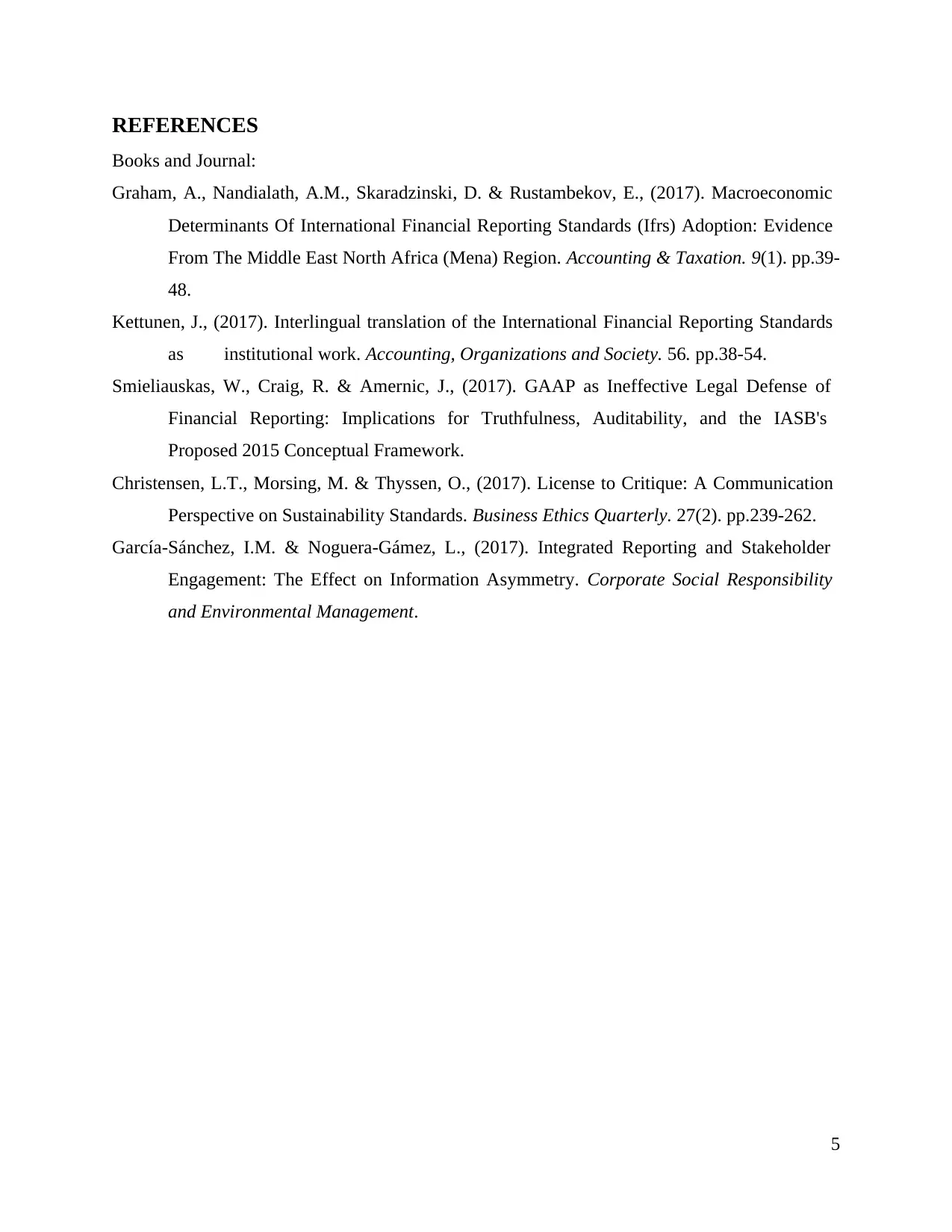
REFERENCES
Books and Journal:
Graham, A., Nandialath, A.M., Skaradzinski, D. & Rustambekov, E., (2017). Macroeconomic
Determinants Of International Financial Reporting Standards (Ifrs) Adoption: Evidence
From The Middle East North Africa (Mena) Region. Accounting & Taxation. 9(1). pp.39-
48.
Kettunen, J., (2017). Interlingual translation of the International Financial Reporting Standards
as institutional work. Accounting, Organizations and Society. 56. pp.38-54.
Smieliauskas, W., Craig, R. & Amernic, J., (2017). GAAP as Ineffective Legal Defense of
Financial Reporting: Implications for Truthfulness, Auditability, and the IASB's
Proposed 2015 Conceptual Framework.
Christensen, L.T., Morsing, M. & Thyssen, O., (2017). License to Critique: A Communication
Perspective on Sustainability Standards. Business Ethics Quarterly. 27(2). pp.239-262.
García‐Sánchez, I.M. & Noguera‐Gámez, L., (2017). Integrated Reporting and Stakeholder
Engagement: The Effect on Information Asymmetry. Corporate Social Responsibility
and Environmental Management.
5
Books and Journal:
Graham, A., Nandialath, A.M., Skaradzinski, D. & Rustambekov, E., (2017). Macroeconomic
Determinants Of International Financial Reporting Standards (Ifrs) Adoption: Evidence
From The Middle East North Africa (Mena) Region. Accounting & Taxation. 9(1). pp.39-
48.
Kettunen, J., (2017). Interlingual translation of the International Financial Reporting Standards
as institutional work. Accounting, Organizations and Society. 56. pp.38-54.
Smieliauskas, W., Craig, R. & Amernic, J., (2017). GAAP as Ineffective Legal Defense of
Financial Reporting: Implications for Truthfulness, Auditability, and the IASB's
Proposed 2015 Conceptual Framework.
Christensen, L.T., Morsing, M. & Thyssen, O., (2017). License to Critique: A Communication
Perspective on Sustainability Standards. Business Ethics Quarterly. 27(2). pp.239-262.
García‐Sánchez, I.M. & Noguera‐Gámez, L., (2017). Integrated Reporting and Stakeholder
Engagement: The Effect on Information Asymmetry. Corporate Social Responsibility
and Environmental Management.
5
1 out of 7
Related Documents
Your All-in-One AI-Powered Toolkit for Academic Success.
+13062052269
info@desklib.com
Available 24*7 on WhatsApp / Email
![[object Object]](/_next/static/media/star-bottom.7253800d.svg)
Unlock your academic potential
Copyright © 2020–2025 A2Z Services. All Rights Reserved. Developed and managed by ZUCOL.





